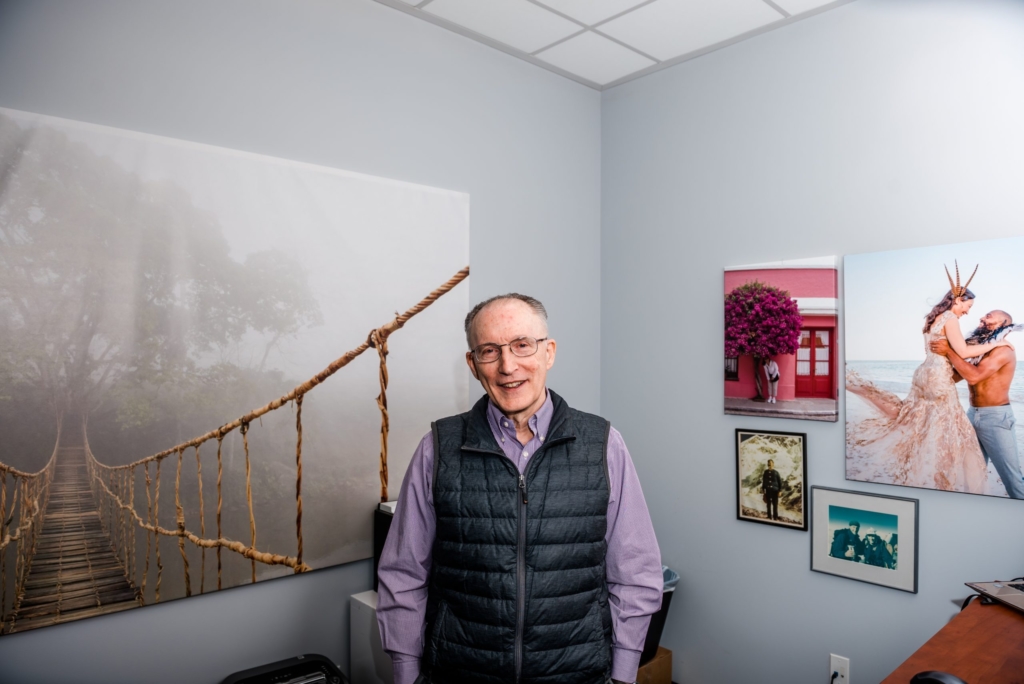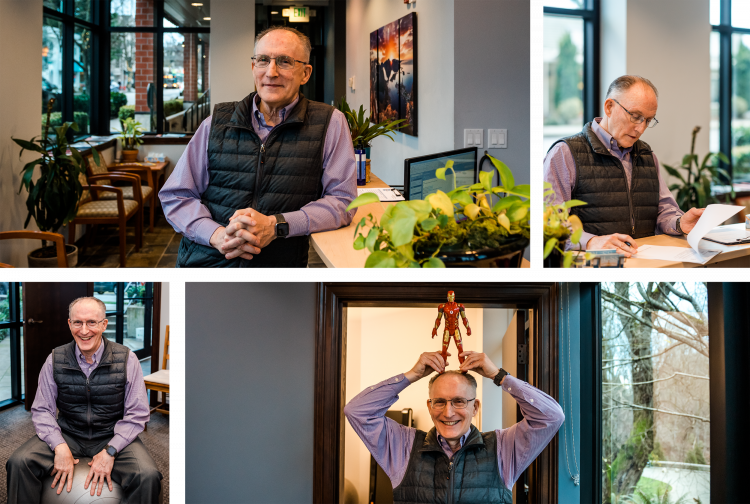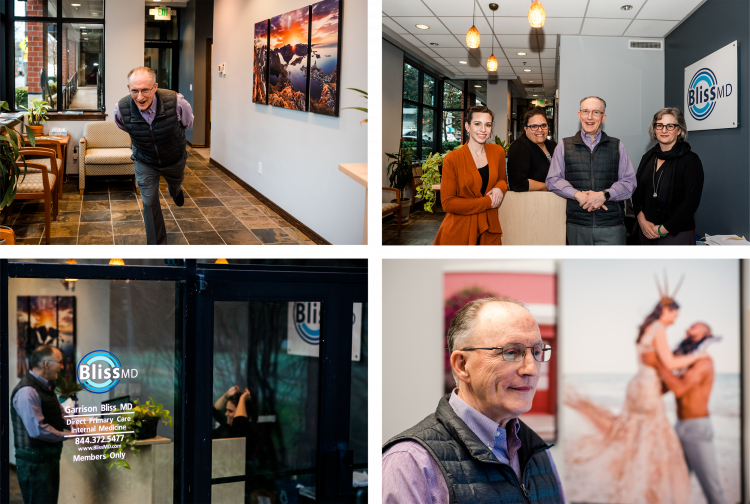The Godfather of Direct Primary Care Creates a More Ethical Career Path for Independent Physicians

When Dr. Garrison Bliss’s son was three years old, he was diagnosed with a brain tumor. The news rocked the family and threw Dr. Bliss, an idealistic young physician fresh off his residency, “into another orbit.” Suddenly, he was spending long hours at a children’s hospital, viewing the healthcare machine from the lens of a patient rather than a physician. He didn’t like what he saw.
His child’s doctors didn’t know what to do. They turned to whole-brain and spinal-cord radiation, a treatment path littered with risk. Dr. Bliss and his wife also had trouble reaching the busy care team, whose members always seemed to be making rounds.
“I began to learn the weaknesses of my sport,” Dr. Bliss recalls. “That all these cool tools we have don’t necessarily only produce good results. They don’t just save lives. They may also damage people in a major way.”
More than 30 years later, Dr. Bliss’s son has a family of his own and a career in software. Radiation treatment staved off brain and spinal cord metastases, but it also affected his endocrine system and spinal development, causing a need for growth hormones.
Overcoming a childhood that was made difficult by both a brain tumor and its treatment wasn’t easy. Nor was it easy for Dr. Bliss to overlook healthcare’s shortcomings after staring at them in his son’s eyes. After his son’s treatment, Dr. Bliss returned to his primary care office in Seattle, Washington, with a simple question: Am I doing what the patient wants or needs, or am I designing my practice around myself?
Not liking his answer, Dr. Bliss took action. He kicked pharma reps out of the office. He stopped doing radiation-heavy chest X-rays as part of every patient’s annual exam. He empowered his employees to advocate for patients, even when that meant changing doctor schedules.
These small changes set him on a trajectory that would forever alter his career — and a small but notable slice of primary care. His change of heart helped improve the health and well-being of tens of thousands of patients and physicians, breathing the first bit of life into direct primary care.
But it didn’t happen right away.
Planting the Seeds of Direct Primary Care

Dr. Bliss was never the kind of person to back down from a just fight. The grandson of a famed abolitionist, he was born to a psychiatrist father and a mother who led local Planned Parenthood and League of Women Voters groups. Dr. Bliss enrolled in Harvard eager to study philosophy and ethics but instead decided to pursue medicine because it offered a chance to do a “pure kind of good.” Even in healthcare, he later learned, business interests ruled.
After his son’s battle with cancer, Dr. Bliss changed the operations and culture of his primary care practice, which thrived for several years. Then, in 1995, two of his partners left to start an invitation-only concierge medicine business, taking along their wealthiest patients. By that time, a hospital system had bought Dr. Bliss’s practice and soon sold it to a company that cut costs without regard for employee retention, physician well-being, or the patient experience. Without the dedication to a more ethical business model, the practice lost its charm and its moral compass.
In his former colleagues’ concierge practice, Dr. Bliss discovered a road map for a different form of primary care, one in which insurers and the dollars were no longer king. He started wondering what great healthcare looked like. The answer: an annual, hourlong exam with every patient, in addition to their necessary care. Then he scoured his spreadsheets and set out to determine what it would cost, per patient, to establish a practice that ran on direct fees rather than reimbursements. He found that the practice would work if each doctor saw 400 to 800 patients, each paying $50 per month.
“We could be available seamlessly to people all the time,” Dr. Bliss says. “We could even take care of our own patients independently, so that they always got their doc.”
The physicians invited 10,000 existing patients to join them. Just 600 accepted the offer. These patients found a different kind of practice where the doctors let them know when it was time to get a flu shot and guaranteed same- or next-day appointments for urgent issues. Dr. Bliss built a first-of-its-kind primary care practice on a foundation of communication, trust, and high-quality care. He became the “Godfather of Direct Primary Care.”
In Pursuit of an Ethical Primary Care Practice
Patients benefit from the direct primary care (DPC) business model because they get to pay a flat fee for medical care, eliminating the burden of uncertainty around healthcare costs. They also get to spend more time with their physician, who’s incentivized to place more of an emphasis on preventive medicine than doctors with a fee-for-service model. Physicians benefit from DPC because they get to practice medicine on their own terms.
“People who do direct primary care are ecstatic,” he says. “They get to feel like they are involved in a mission that’s worth getting involved in.”
Direct primary care practices often don’t accept health insurance and are even known to keep patients so healthy that they avoid costly emergency room visits. That makes the model something of a threat to the nation’s payers and the healthcare system, which has elicited strong backlash from insurers and regulators, as Dr. Bliss has seen firsthand.
Patients, however, loved it. Two years after starting the nation’s first direct primary care practice, Dr. Bliss and his team reached capacity and stopped accepting new patients. Profits soared past expectations, and so did outcomes. When patients came in, doctors spent at least an hour with them, treating health conditions that might otherwise have landed them in the emergency room. Technology became a benefit, not a burden. Lab work orders dropped. Patients received attention and advice that empowered them to manage their health.

“When we were fee-for-service, there were people running up and down our halls all day long. We were feeling pressured all the time to get people in and out,” Dr. Bliss recalls. “Direct primary care meant that not only could we provide more services, but the patients felt like they were luxuriating in healthcare rather than being a necessary evil in our office.”
A Primary Care Practice in Revolt
Dr. Bliss was dictating a patient chart when he heard a knock on the door. One of his partners’ patients walked through the door. His name was Nick Hanauer, and he said he was the first outside investor in a hometown company called Amazon. He had spent a lot of time searching for a healthcare play, and he thought he finally found the answer. The men went out for coffee, during which Hanauer tried to sell Dr. Bliss on a startup that practiced direct primary care for wealthy people, similar to his ex-partners’ practice. Dr. Bliss proposed an alternative: Instead of catering to the rich, turn the business model into a nationally scalable company. Believing in his idea, Hanauer invested the first $1 million in an ambitious direct primary care organization named Qliance Health.
The venture earned incredible interest from the healthcare community, investors (including Jeff Bezos), and the mainstream press. It emerged as the model that could disrupt primary care and, consequently, the entire healthcare system. But that attention also drew the ire of direct primary care’s detractors.
Tipped off by a payer, Washington State’s insurance commissioner claimed that Dr. Bliss was providing a form of health insurance without a license and threatened to shut down the practice. Dr. Bliss had three options: give it all up, don’t take insurance and become an actual insurance provider, or accept insurance and violate those contracts by taking monthly fees. Not pleased with any of the choices, he mobilized 2,400 patients to write letters demanding that the insurance commissioner allow them continued access to their care. In the face of protest, the commissioner relented.
Direct primary care was so novel that its legal existence called for new legislation. Dr. Bliss, his peers in newly formed direct primary care practices, and hesitant state lawmakers went back and forth on the proposal, negotiating complexities that could cause the sector to thrive or die. Finally, the legislature passed a bill that would have required direct primary care organizations to pay taxes as if they were insurance companies.
“It would mean a dramatic reduction in our profit,” Dr. Bliss says. “We would be worse off, and most of us were just barely doing this version of practice.”
When the bill reached the governor’s desk, he took his pen and crossed out the tax language. Thanks to Washington State’s remarkable gubernatorial power, direct primary care marched on.
Under the direction of Dr. Bliss, his physician cousin, and his Harvard MBA brother-in-law, Qliance Health operated for a decade, striking deals with tech companies, sports teams, and even traditional healthcare organizations. Patients and clients raved, and early data suggested that direct primary care was improving patient care and the bottom line.
Even when the new model delivered strong results, longtime healthcare stakeholders remained skeptical and, at times, outright hostile. The inability for key stakeholders to grasp Qliance caused its demise. The company had struck a deal with a Medicaid organization whose reach expanded Qliance’s patient load from 10,000 to 40,000 in months. The business partners agreed to split cost savings that resulted from Qliance’s work. Dr. Bliss claims that his team saved millions of dollars, reducing utilization across healthcare and providing eight times the amount of primary care. However, the managed care company refused to pay when its leaders learned that Medicaid wouldn’t cover the tab, arguing that Qliance had taken on healthy patients who required little care.
The healthcare system, with its complexities and red tape, won. After nearly a decade, Dr. Bliss left to start a new solo practice because of the contract problem and his desire to cool down in the run-up to retirement. The Medicaid debacle proved detrimental to Qliance Health, which soon went out of business.
Dr. Bliss Predicts What’s Next for Primary Care

Whether direct primary care will continue its ascent depends on whether physicians will adopt the controversial but valuable business model. To that end, Dr. Bliss shares some of the lessons he learned along the way:
- Make sure you want it. It’s difficult to get a new direct primary care practice off the ground. Take courses from the American Academy of Family Physicians and read pieces produced by Dr. Bliss and colleagues such as Dr. Philip Eskew, the pioneers of direct primary care who share the common problems they faced — and how they overcame them.
- Get a mentor. If possible, find a practicing direct primary care physician and ask if they need a partner. Seek out their advice. They will help because they want to see the model take flight.
- Find the right partners. Dr. Bliss praises his electronic health records vendor, Elation Health, for supporting direct primary care by developing software that works for him. Strong data collection can “reduce the hazard” of practicing direct primary care in a fee-for-service world, he says.
Now, just a year away from retirement, Dr. Bliss sees many of the same patients who have been coming to him since 1997. He continues to advocate for direct primary care, voicing his views on proposed bills and speaking and writing about hot issues.
“For me, it’s a little bit like the end of the movie ‘The Godfather,’ when he’s wandering around in the garden with the grandchildren,” Dr. Bliss says. “I have something to look back on — and something to look forward to. We aren’t done. This isn’t over.”






